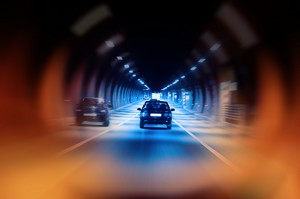Intelligent Transportation: Tunnel Vision
 |
Engineering technology is proving that there are no limits to the length of tunnels that can be built through the Earth’s crust. No longer do geologists have to look for the softest rocks, with exciting new drilling machines they can plough their way through some very tough rock.
However, the problem with tunnels, especially ones through which cars flow, is that humans drive cars and cars, either through the fault of the driver or mechanical failure are quite frequently hazardous and sometimes fatal. Since it’s not practical to stop people driving through tunnels, tunnels have to become safer.
Luckily for us, advances in computer and video technology are helping the people involved in accidents get out safely and prevent more cars becoming involved.
We’re used to seeing cameras in tunnels and these are connected to a central traffic monitoring system where operatives continuously watch the situation. However, no matter how well trained the operatives are, they are only human and in the blink of an eye an accident can happen, therefore what is needed is automatic accident detection.
Several companies are producing the technology capable of automatically detecting incidents and they do this through the use of multiple systems.
Loop detection systems, are wire loops spaced periodically throughout the floor of the tunnel (at a recommended maximum distance of 100m) and are used to provide traffic flow information to the control center.
Radar detectors placed in the ceiling transmit microwaves to cars where the signal bounces back to the receiver the time it takes to be received is measured and using the Doppler Principle the speed of the vehicle is calculated.
Video incident cameras or , placed throughout the tunnel send their real-time data to servers in the central control room where their mathematical algorithms analyse the video and, if necessary, send sending visual and audible alerts. These servers are looking for unusual occurrences such as slow moving traffic, erratic driving, cars travelling the wrong way, debris and pedestrians. If the incident requires further attention control center operatives can then take the appropriate action such as rerouting traffic, sending patrol cars, posting messages on display boards. At entrance to the Mont Blanc tunnel, thermographic imaging cameras detect overheating vehicles where they are stopped and prevented from entering the tunnel.
Of course these systems detect incidents that can be seen, but sometimes the most dangerous incidents can initially be invisible and this is why environmental and air quality (AQ) monitoring devices and fire detection systems are used.
Environmental and AQ monitoring systems detect noxious gasses such as carbon monoxide and nitrous oxide and to ensure that drivers have the best visibility, important in tunnels with a high percentage of diesel-fueled vehicles, Beam detectors, are installed. Beam detectors are light emitters and receivers placed on opposite walls, where in normal light conditions all the light sent from the emitter is received by the light sensitive device in the receiver. If the received light levels fall below a certain level an alarm will be triggered.
Automatic Fire detections systems use a range of systems such as the previously mentioned video system; linear heat detectors which use linear temperature sensor cables to send an alarm if the temperature rises above a certain point; spot detectors are similar to the cables in that they trigger and alarm when the temperature rises above a certain level; and manual fire alarms are located in sidewall niches which can be pulled when a fire is seen.
It is thanks to these systems that in the event of a tragedy in a tunnel it won’t get any worse than necessary. |